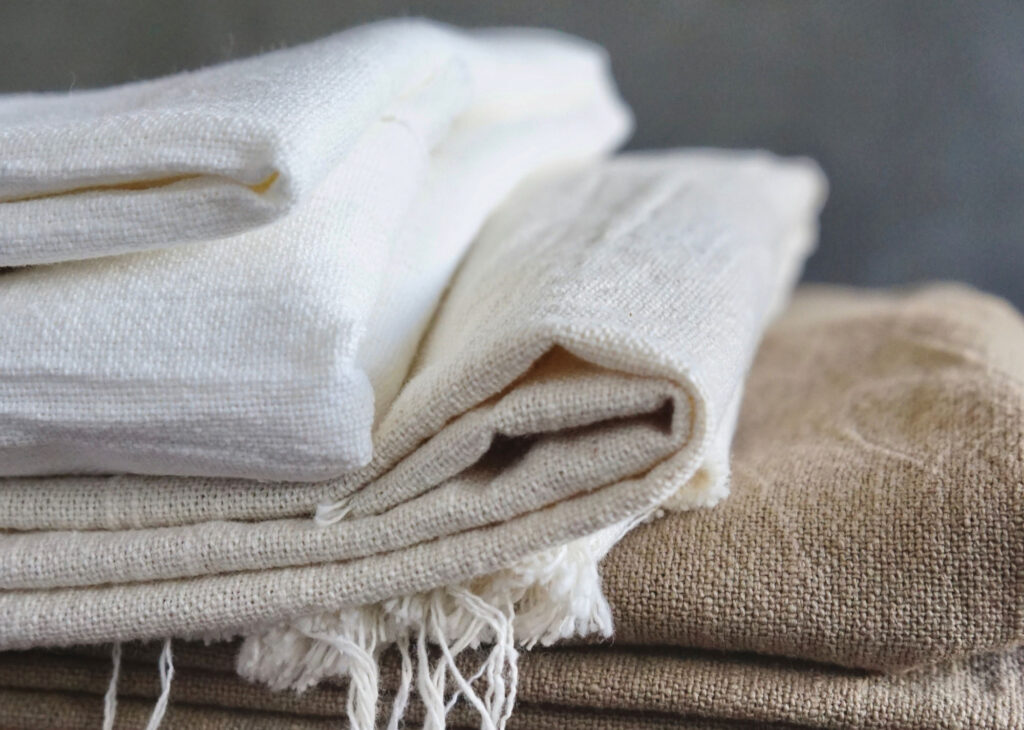
We hear a lot about swapping, mending, donating and recycling your clothes. Of course, focusing on buying sustainable, natural fabric clothes to begin with is a huge sustainability bonus. But when a garment has reached the end of its life, can you simply throw it in the trash? Are some clothes more biodegradable than others? Let’s take a look at how long the most popular fabrics take to break down and how to compost your clothes at home.
Cotton – 1 week to 5 months
Cotton is one of the most biodegradable natural fabrics available — if it’s organic, untreated, and not mixed with synthetic fibers. Close the Loop estimates that pure, organic cotton can break down and return to its original carbon state in as little as a week if it’s composted under the right conditions. Before composting that cotton tee, underwear, or pair of socks, check that it’s 100% cotton and free from harmful treatments and dyes that could leach into your compost.

Linen – 2 weeks
Linen comes from the flax plant and is used to produce breathable fitted shirts and pants. As a 100% plant-based material, linen degrades extremely quickly when composted — two weeks according to some estimates. To help your linen fabric break down faster, cut it into small strips before composting.
Hemp – 2 weeks
Similar to linen, hemp clothing breaks down quickly in a healthy compost pile and returns to the soil from which it came. Hemp is becoming a popular material for everything from tees to tote bags and is valued for its low environmental impact. One hectare of hemp can draw down 10.5 metric tons of carbon dioxide from the air when grown using organic, regenerative farming techniques.
Denim – 10 to 12 months
While the original denim is made from 100% cotton, it takes a little longer to break down because of its thicker and denser construction. Before composting those worn-out jeans, check that they are made from pure cotton and don’t contain synthetic materials. Lee and Levi’s are two brands that sell 100% cotton jeans, though the cotton is not yet organic.
Bamboo, Soy, Pine, and Lyocell
These modern man-made fabrics are produced from processing plant-derived cellulose via the use of chemicals in a closed-loop system. While some estimate that pure bamboo viscose takes a year or more to break down, there is very little data available on the true biodegradability of these fabrics. Many of the cellulose fabrics produced today are mixed with synthetic fibers to make them stronger and help them to hold their shape. To make your purchases more sustainable, look for garments that are made from 100% plant-derived cellulose and colored with low-impact dyes.
Recycled Polyester
Polyester is a synthetic fabric that currently accounts for around 52% of the textile industry. Unfortunately, it takes between 20 and 200 years to break down. To tackle this pressing problem, some manufacturers are recovering used polyester and spinning it into a recycled polyester fabric for use in swimwear and activewear. While recycled polyester can’t be composted, it can be taken to a fabric recycler to be rewoven over and over again.
Tips for Disposing of Your Worn-Out Clothes
Finding clothing from natural materials is easier than ever thanks to sustainable stores like Faerie’s Dance. But what do you do once you’ve worn the clothes for years and they are literally falling apart? After reusing, repairing, and repurposing your clothes, check that they’re 100% natural and toxin-free, remove any metal rivets and zippers, and add the fabric to the compost pile.
In landfills, clothes produce methane (28 times more warming than carbon dioxide over 20 years) rather than break down quickly with the help of microbes. By composting your well-worn, natural fabric clothing yourself, you will not only have complete control over the ingredients that go into your compost pile, but you’ll have rich organic matter for the garden (or the local organic hemp farm) and the cycle can start all over again.
